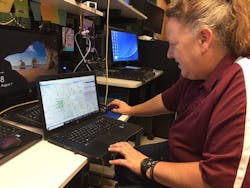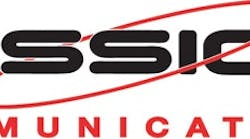The city of Springfield, Mo., has a service area of 82 sq miles with a population of about 160,000. City officials have used Mission Communications remote terminal units (RTUs) to monitor rainfall since 2007. Carrie Lamb, water quality compliance officer for the city of Springfield, said the Department of Public Works (DPW) needed a network of rainfall gauges interspersed across the city to collect consistent, long-term data.
“I did a lot of research online and spoke with other communities,” Lamb said. “Some had systems they were supporting internally. We wanted a system that we didn’t have to support ourselves. That was a really important consideration for us, and that’s how we came to Mission.”
The city began with 20 solar-powered M110 units attached to tipping bucket rain gauges. Solar power was chosen for cost efficiency and to follow the department goal of maintaining a clean environment. The majority of the units were positioned on roofs of school buildings and near lift stations as a way of spacing the network.
Since that time, Springfield has added about 30 units to its application and integrated the system to other divisions. It uses 46 Mission RTUs to monitor rainfall and flow to understand how water is moving through the city. Mission data helps utility staff members make important decisions about city operations. Rainfall data is used in the Department of Environmental Services’ (DES) storm water program to formulate an approach for reducing pollutants in storm water runoff and a means to better manage city floodplains. The data also is used to determine to what extent the city wastewater treatment plants need to be extended and where infrastructure upgrades are needed most.
The DES and the DPW use rainfall data for several purposes. Lamb said her division primarily uses it for storm water sampling. If at least 0.2 in. of rain accumulates in an area after three or more days of no rainfall, Lamb and her team sample the storm water where it feeds into creeks and ditches. They test the storm water and determine what action may be necessary to mitigate the amount of pollutants that are exposed to the environment. Lamb said they also use the rainfall data to target industrial areas to make sure that facilities are following codes intended to protect water quality by reducing storm water pollution.
Chris Dunnaway, principal storm water engineer for DPW, said his division is responsible for managing the city storm water system. As part of this, hydrologic models have been developed for many of the watersheds in the city. The models are used to estimate the amount of rainfall that runs off during a storm event to provide an approximate flow rate value. The flow rates are entered into a hydraulic model to predict how high water will rise during storms of various magnitudes. Both models rely on engineering judgement of multiple variables.
Rainfall data collected during a storm event, in combination with recorded high-water marks, assist city staff with calibrating and refining the models to better match what occurs. The rainfall gauges show not only where the rainfall occurred, but also how hard it rained and for how long with rainfall measurements provided at 15-minute intervals. This temporal distribution is important in storm water modeling.
These models are primarily used during the design of storm water infrastructure such as culverts, bridges and detention basins to reduce flooding of streets and private property. The models also were used during city floodplain remapping to identify areas that are at a higher risk of flooding.
“During the remapping process, we believed one of the hydrologic models was overly conservative, so we looked at a couple of the rain gauges from a specific storm event and used that data to help calibrate the model,” Dunnaway said.
The data helps determine which parts of the city need critical attention in the way of storm water infrastructure upgrades. Dunnaway said these upgrades include enlarging a detention basin, improving a channel or installing larger pipes.
Springfield city officials publicized their Mission website, so members of the community can access the rainfall data for various projects. For instance, Lamb explained that in compliance with the Clean Water Act, contractors in the area are required to maintain certain practices to limit the amount of mud that gets into fresh water sources from construction sites. Contractors use the rainfall data to identify the sites that need to be inspected. Local engineers consult the data when they are in the process of designing storm water projects and solutions.
The DES also oversees the sanitary sewer system and the city treatment plants. Springfield has two treatment plants, one that treats an average of 35 million gal of water per day (mgd) and a smaller plant that treats an average of 8 mgd. Karyn Highfill, control systems specialist for the city of Springfield, worked closely with Mission and the staff from DES to implement a plan to combine all the information from rain data and pump data into the website.
John Copelin, maintenance supervisor of electrical instrumentation and control for the city of Springfield, said in 2017 his department began using the previously unused input capabilities of the Mission RTUs that were already installed at pump stations for rainfall collection.
Copelin’s department uses the rainfall data to determine the effectiveness of its pumps and anticipate preventive maintenance.
“During rain events, we can see how many inches of rain fell in this area, and then we can look at the pump station that is in that area and see how many minutes it runs longer than normal, and that gives us the data we need,” Copelin said.
They also use flowmeters at select stations, which generate charts and graphs to show them how much water is coming in and being pumped out of the station. All the data combined helps the city of Springfield make informed decisions, including localizing areas of the city where sewer pipelines need to be repaired or reinforced, as well as whether treatment plants may need to be expanded to accommodate extra flow.
In addition to rainfall data, Springfield uses M800 and MyDro 850 (800-series) units to monitor pump starts and runtimes.
“I love the display that the MyDro has, and that you can actually read the status of the discrete and analog 4–20 [mA] current inputs,” Copelin said.
Pump information is used to indicate the need for preventative maintenance to keep operations running smoothly. According to Copelin, the city has one of the strictest effluent permits in the state of Missouri because most treated wastewater is returned to creeks and rivers that flow into Table Rock Lake.
“Our effluent is extremely clean and it’s virtually drinking water quality when we release it back into the environment because of the topography of the Ozarks,” Copelin said. He said the new system has helped Springfield stay attuned to its application better than the previous system, which has resulted in fewer negative incidents.
Prior to Mission, the DES used a system of auto-dialers that relied on telephone landlines, which were susceptible to poor connections and lightning strikes. At that time, there was one phone number specifically designated for alarm call-outs at the treatment plant. An operator would receive the phone call, manually log it and pass the information along to another staff member.
“Mission uses the cellular system. There are no phone lines to worry about, and the cell signal is very robust and dependable,” Copelin said. “When something happens, the Mission unit sends emails, texts, and calls to multiple people. Additionally, I get an email for everything that is happening from the station, so I can create a log based on the emails I receive.”
Copelin told an anecdote about a sewer spill the utility experienced prior to implementing these units. There was a severe thunderstorm one Saturday night near the second largest pump station in the city. A lightning strike traveled through the phone line, burned up the auto-dialer, and tripped the breaker in the station. The lightning strike split the phone line feeding into the auto-dialer, leaving char marks on the wall. The power outage made the unit unable to call out, so the station was not pumping any sewage until an operator discovered what had happened the following Monday morning. The well had been overflowing into a nearby creek, and they had to report the spill to the U.S. Department of Natural Resources and U.S. EPA.
“If we had a Mission unit there, that wouldn’t have happened,” Copelin said. “The power would have gone out, and we would have known that the well was high because the Mission RTU has its own battery and uses the cellular network. As soon as the power went out, it would have started sending us alarms and we would have been able to send someone out there.”
The RTUs provide the city of Springfield with a reliable solution for many of its operations.
“The Mission units have made my job easier,” Copelin said. “Making the transition from the old technology was easy. We were able to use the same wiring. It’s an easy install and easy switch. So far the Mission units have worked flawlessly and we’re very impressed with them.



